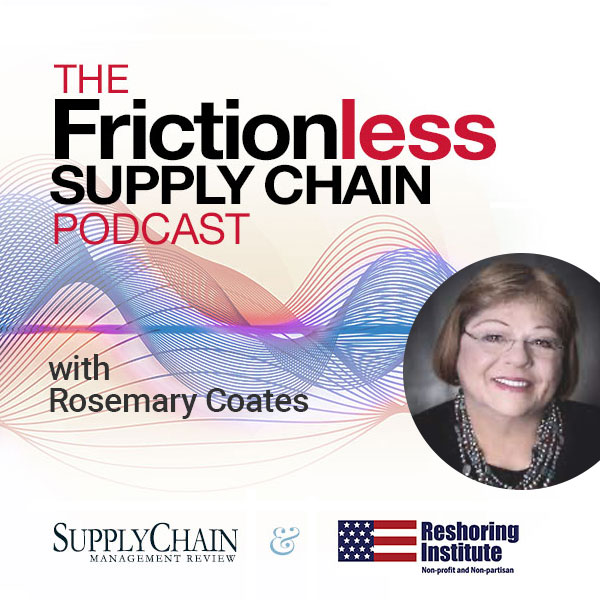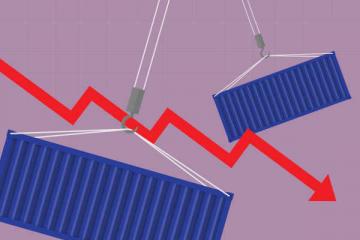There is little question that COVID-19 has put the global economy in a tail-spin and left most supply chains treading water. AGCO, a public company with over $9 billion in annual revenue, is one of the exceptions. A global manufacturer and distributor of agricultural equipment and replacement parts with a presence in heavily-impacted geographies such as China and Italy, AGCO took pro-active steps to address the crisis as early as January.
The result is that AGCO has been extremely nimble and agile in navigating through the COVID-19 pandemic that has devasted so many multinationals' global supply chains. That is important in a supply chain that includes 41 manufacturing and assembly locations, 37 distribution facilities and thousands of suppliers. AGCO's products are marketed under several well-known brands including Challenger, Fendt, GSI, Massey Ferguson and Valtra.
Agricultural equipment manufacturers have certain advantages that other multinational manufacturers do not. The world needs farmers to continue to plant and harvest crops. As such, companies like AGCO and competitors such as Deere & Company are what the U.S. calls “federally designated essential critical infrastructure businesses.” That ungainly phrase means these companies are critical and can stay open if they can demonstrate and maintain safe working conditions for their employees.
The other advantage agricultural equipment manufacturers have is that despite the recession, demand for their products remains high. For AGCO, there are plants that have order banks extending many months. And the need for spare parts never goes away.
 Behind the scenes, there is a remarkable story of resiliency occurring at AGCO. I've long admired AGCO's supply chain risk management and strategic sourcing capabilities. AGCO supply chain executives have spoken on panels I have organized at various supply chain conferences. I reached out to Greg Toornman, AGCO's vice president of global materials, logistics and demand planning, and heard how the supply chain organization has responded during the crisis.
Behind the scenes, there is a remarkable story of resiliency occurring at AGCO. I've long admired AGCO's supply chain risk management and strategic sourcing capabilities. AGCO supply chain executives have spoken on panels I have organized at various supply chain conferences. I reached out to Greg Toornman, AGCO's vice president of global materials, logistics and demand planning, and heard how the supply chain organization has responded during the crisis.
The China Supply Chain
“The supply side of our global organization talks at least once every week,” Toornman explained. “Our global leadership team (Global and Regional) and front-line reporting employees in each region align on activities, supply escalation, initiative implementation and performance. We have been doing this for eight years. We talk about what we are hearing from suppliers and customers.”
Listening proved crucial. In mid-January, the supply chain organization began to hear about what we now call COVID-19. The company did what it normally does around operational problems: Perform a risk assessment. Employees in China began talking about what was happening there and what the supply team might expect to happen.
The company explored sourcing options and alternatives. “But things got worse,” Toornman told me. “By the third week of January we put together a task force team for managing during this crisis. That team is still operating.” The task force started having calls with the company headquarters in Duluth, Georgia twice a week. Plant managers, materials and logistics managers, purchasing, supplier quality and finance all participated in the sessions. Questions included: “Where are we at? What is our capability to get critical supplies from suppliers outside of China? What is your capability to ship needed components to our plants in Europe? When does it look like things will open up again?”
As China was shutting down, the team began to prepare for when the restrictions would end and China would be authorized to return to work. Members assessed whether their plants had enough personal protective equipment (PPE) to operate, and whether their Chinese suppliers had enough PPEs. “We started amassing PPEs in Chicago,” Toornman explained. The decision was made to distribute PPEs to critical suppliers on the condition that they would work on AGCO orders before any of their other customers.
The mass buying started in January and has continued through the crisis. Initially, PPEs were purchased in Europe, North America and South America and then moved to China. Now, as China has begun going back to work, AGCO is buying PPEs from China and moving them to the Americas and Europe.
To make sure European plants stayed supplied with components, the team focused on producing as many of the critical components as possible. They then shipped them by train across Russia rather than using the longer transit time and less expensive Ocean mode of transport. “Rail was our fall back mode,” Toornman declared. “We payed 85% more than sea freight, but 90% less then air freight.” But most importantly, “Sites in Europe felt no impact from the China industrial shutdown,” he said.
AGCO's material planning team in China oversaw the Chinese supplier recovery and global shipping on behalf of AGCO plants across all regions. Partly this was because of time differences and because the AGCO local staff spoke Mandarin. But they also wanted centralized decision making on where the shipments were going. They did not want the different plants fighting each other for supply. Central allocation decisions were made – factories with higher gross margins got a higher allocation - and the China staff enforced those decisions.
After a two-week shutdown, factories started opening in China outside of Wuhan on February 10th, if the plants could demonstrate and maintain a safe working environment. What is a safe working environment? Worker temperatures are tested as they enter the factory to make sure they don't have a fever. Workers line up outside standing at least two meters apart to wait their turn. Place mats on the ground are spaced two meters apart. Everyone in line wears masks. Workers are given a daily allotment of masks and gloves. Workstations were moved to insure the 2-meter spacing requirement. Proper spacing is respected during breaks and at lunch. Chinese authorities have the authority to make spot inspections at any time.
“We were not able to achieve full productivity in the beginning,” Toornman admitted. “But tach times were adjusted,” workers stepped up and productivity has surged. The week of February 10,, the company shipped 10 containers out of China rather than the normal 75 per week they ship. But, by February 24th, the third week back, AGCO was up to its normal 75+ containers per week. The first week of March, the company shipped 105 containers.
European and Americas supply chains
The China safety protocols are now in place at all AGCO's factories around the world. The lessons learned from China and the resulting pandemic operating procedures are being applied across all regions and facilities.
AGCO has a risk notification and visualization solution from riskmethods, the supply chain risk management software firm. This solution has a graphical view of the AGCO supply chain across multiple supplier tiers. If a supplier's continued material flow becomes questionable for a wide range of reasons, the way that supplier's components flow to various factories and nodes in the supply chain is graphically illustrated and the appropriate commodity managers are automatically notified. Riskmethods works by continuously monitoring a wide variety of risks, identified based on monitoring hundreds of thousand online and social media sources, and then elevating risks in heat bubble maps.
This tool became a critical success factor during the pandemic. AGCO was able to predict the South Korean shut down two to three days before it occurred and accelerate the impacted suppliers' shipments out of that nation prior to plant closures. These suppliers' plants are now operating again.
The ability to predict when shutdowns would occur improved over time. In forecasting lock downs, AGCO looked at infections per million people (PPM) per country. “Once infections get to 50-60 ppm, governments begin to take action. By 100 infections PPM, restrictions are in place,” Toornman said. “We were able to predict the Italian shut down seven days before it occurred.”
This was critical, since AGCO has 240 suppliers in Italy, including 184 located in the high-risk zone in Northern Italy. The seven working days lead time allowed the company to pull shipments out in front of the lock down. “We could do this surgically,” Toornman continued. “We knew a supplier in this postal code had a higher priority than one 50 kilometers to the west.”
The shut-down forecast also allowed the company to position extra PPEs at its three Italian facilities. Then the company worked with its Italian lawyers to get a special industry designation that allowed them to legally keep working. They got those documents quickly, and then got them in the hands of all employees and suppliers in 24 hours. This allowed key suppliers to keep operating for another two weeks after many of the companies in the affected were shut down.
By March, the company had been impacted by incremental, country by country shutdowns across Europe. The ability to forecast worsening conditions in nations allowed AGCO to forecast lock downs in Switzerland, Spain and Sweden ahead of time, and follow the same game plan it had implemented in impacted locations in Italy. It is also better prepared to start operations once governments give the go ahead. AGCO has prepositioned PPEs in the region, has visibility to where critical parts are and has teams focused on intelligently expediting the most critical components.
In Brazil, it looked like the company would have to spend money to expedite key materials into the region from the affected China and European supplier sites. But the sales team worked with customers and said “if you want the tractor you have ordered (every tractor has a unique configuration), it may take a bit longer, but we will fulfill the order. But since the order is only being affected by a few components, if you are willing to accept a similar configuration, which is very similar to what you ordered, we will be able meet the original schedule.” Using this methodology and many additional local supply chain initiatives, the company was able to reduce projected air freight costs by 75%.
In North America, all AGCO sites are running full out while competitors appear to be shutting down plants in the region. The AGCO team in North America is utilizing the same innovative tools and approaches that were successfully executed in China, Europe and South America. For instance, when AGCO received notices from several suppliers defining shutdown schedules, the company was able to provide the supporting documentation to allow the suppliers to continue to produce and ship AGCO product needs as a result of the “essential” industry classification. AGCO was able to provide suppliers with PPE and documentation to sustain product that enabled suppliers to stay open or reopen in order to support AGCO's global requirements.
Agility doesn't just happen; these capabilities are developed over time.
AGCO's agility story began back in 2004, when the company launched a transformation of its sourcing organization. AGCO moved from a fragmented and decentralized procurement to a centralized commodity management structure in order to balance buying synergies with an increased focus on risk management. Implementation of standardized roles and responsibilities, and global policies and procedures, were supported by an extensive change management program. The company formed a School of Purchasing to further develop the capabilities of the organization.
The risks associated with sourcing became part of each category manager's job; these managers became responsible for supplier risk management, not just savings. For AGCO, a “best cost sourcing strategy” includes multi-sourcing, a certain percentage of components are produced locally and a certain percentage – depending on the brand and its go to market strategy - comes from companies in best cost countries. The percentage of goods sourced locally changes based on exchange rates, tariffs, the volume of goods needed and other considerations. But the company almost always has domestic sources for the components that go into the agricultural equipment produced in that region. Local companies can respond more quickly when something goes wrong.
Back in 2008, Toornman said, “we needed to teach buyers that sourcing is about more than costs. We needed a risk factor in there. If something goes wrong, what is the cost to remedy that situation? If quality is bad, how fast can we respond? It is difficult to teach people that. People like to plan as if the glass is full. The glass is never full. It may be half full, or three quarters full, but it is never full.”
During this journey, starting in about 2012, the procurement organization digitized its sourcing operation. The organization implemented an e-sourcing platform from Synertrade. This platform automatically captures material costs, overhead rates, labor costs, duties, inventory carrying costs and packaging costs. These costs determine the total cost of ownership (TCO). “Buyers do not need to ask anyone for any of these costs,” Toornman explained. “They can see the full costs in an apples-to-apples, supplier to supplier, comparison.” The platform also includes an analysis of what the cost of failure is, whether it is low, medium or high. Higher risk materials pay a penalty that gets reflected in the total cost of ownership.
Material planners are expected to regularly communicate with suppliers and learn what is happening at the supplier; for example, whether a plant learns a shipment might be delayed beforehand rather than after it has not shipped on time. Toornman spoke of a “relationship ratio” that reflects how often material planners and their suppliers are talking. “We see a significant difference, if a material planner at a plant must communicate with 35 suppliers versus a material planner working with 55 suppliers,” he said.
Final thoughts
Toornman concluded by saying, “Years ago, we began our materials management transformation. We wanted to build a supply network that would be flexible, adaptable, that was digitized, standardized and effective. Tools were important. But people and processes are also key. Culture binds everything.” AGCO is a company committed to continuous improvement, so improvements to sourcing and agility continue to improve.
In this crisis, Toornman also points out that employee messaging has been critical. “People want to work,” he noted. “Farmers must get seed in ground. Customers want our products across the globe. It is critical.” Within the organization these messages, along with the efforts they were taking to keep workers safe, were used to mitigate fear and motivate people to come to work and work harder through these difficult times.
Steve Banker is an analyst and vice president of supply chain management with ARC Advisory Group. He can be reached at [email protected]. This article was condensed from a piece that originally appeared on LogisticsViewpoints.
SC
MR


Latest Supply Chain News
Latest Podcast

 Explore
Explore
Latest Supply Chain News
- A reshoring history lesson
- Strategic cost savings differ from cutting costs
- Planning fatigue may be settling in
- Inflation, economic worries among top supply chain concerns for SMBs
- April Services PMI declines following 15 months of growth, reports ISM
- Attacking stubborn COGS inflation with Digital Design-and-Source-to-Value
- More latest news
Latest Resources

Subscribe

Supply Chain Management Review delivers the best industry content.

Editors’ Picks





